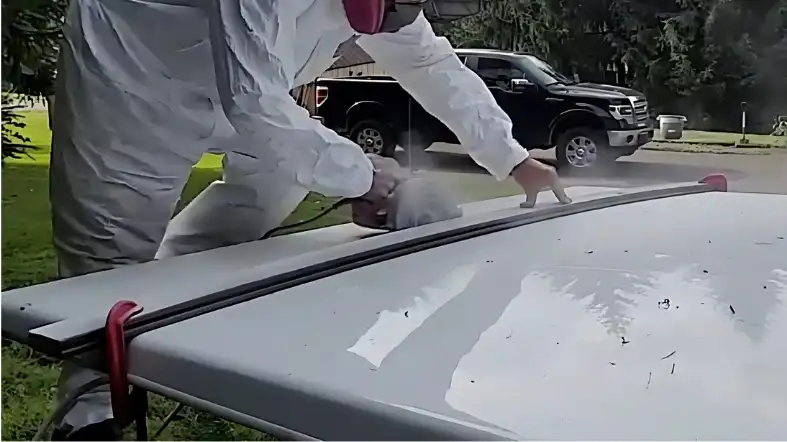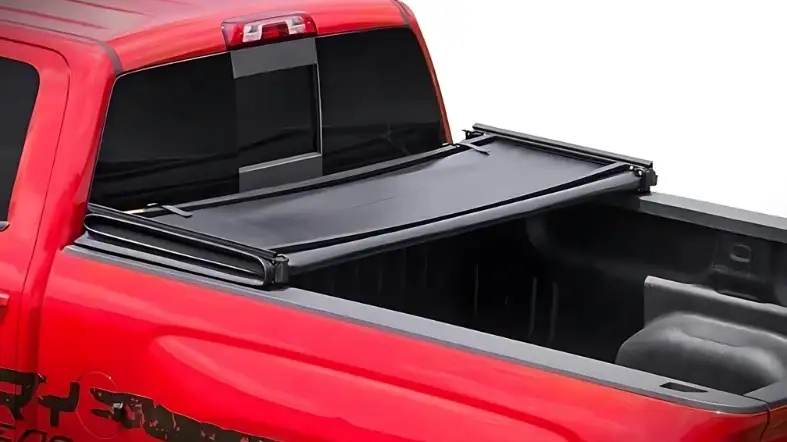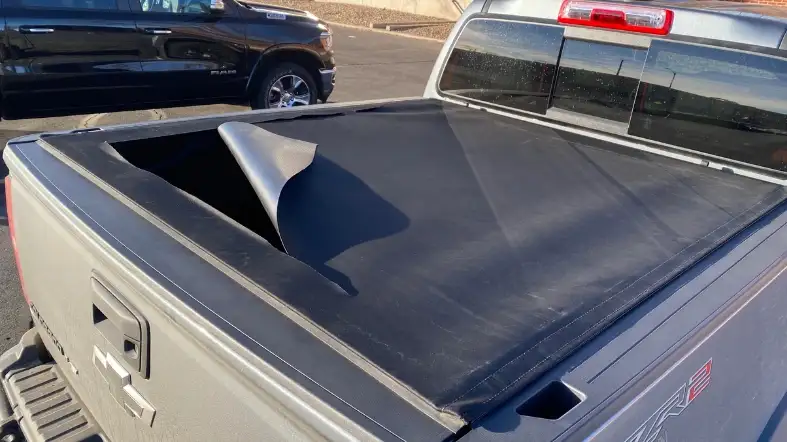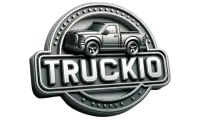Looking to customize your truck bed? Is a soft or hard tonneau cover better to cut? Explore the possibilities as we delve into the world of tonneau cover cutting.
We all answer your question and explain everything you need to know.
Like, factors to consider before cutting, when you should cut the tonneau cover, the step-by-step procedure, pros and risks of the tonneau cover.
We also cover some FAQs related to tonneau cover cutting.

Can You Cut A Tonneau Cover?
Yes, you can cut a tonneau cover. Use a circular saw or sawzall with a metal cutting blade. Measure carefully, cut slowly, and wear safety gear.
Seal the edges afterward. Consider using a heat gun for hard covers or removing fabric from soft covers. Professional help is an option but check the warranty first.
Quick Comparison: Cutting a Hard Tonneau Cover vs. Cutting a Soft Tonneau Cover
| Feature | Hard Tonneau Cover | Soft Tonneau Cover |
|---|---|---|
| Difficulty | Difficult | Easy |
| Time | Time-consuming | Quick |
| Tools | Saw, sander, sealant | Sharp knife or scissors |
| Cost | More expensive | Less expensive |
| Durability | More durable | Less durable |
| Appearance | More finished appearance | Less finished appearance |
Factors to Consider Before Cutting a Tonneau Cover

The type of tonneau cover
Hard tonneau covers are typically made of aluminum or fiberglass, while soft tonneau covers are made of fabric or vinyl.
Hard tonneau covers are more durable than soft tonneau covers, but they are also more expensive. Soft tonneau covers are less expensive, but they are not as durable.
Cover Design
Examine the design of your tonneau cover. Some covers have built-in rails, clamps, or other structural elements that may interfere with cutting.
Understanding the design will help you plan where to cut without compromising the functionality of the cover.
The purpose of the tonneau cover
If you need a tonneau cover to protect your cargo from the elements, you will need a hard one.
If you need a tonneau cover to keep your cargo secure, you can choose a soft or hard tonneau cover.
The size of the tonneau cover
Make sure to measure the bed of your truck before you buy a tonneau cover.
Some tonneau covers are designed to fit specific truck models, while others are adjustable to fit most truck models.
The warranty
Some tonneau covers come with a warranty, while others do not. If you are unsure about whether or not you can cut your tonneau cover, you should contact the manufacturer for more information.
Weather Protection
Consider the impact of cutting the tonneau cover on its ability to protect your truck bed from the elements.
Assess whether sealing the cut edges will prevent water or debris from entering the truck bed, ensuring your cargo remains secure and dry.
Aesthetics
Think about the visual impact of cutting the tonneau cover. Assess how the cut will affect the overall appearance of your truck.
If aesthetics are a concern, explore options such as removable or modular tonneau covers that can provide the desired functionality without permanently altering the cover.
Expertise and Tools
Evaluate your skills and experience in handling tools and performing modifications. Cutting a tonneau cover requires precision and proper tools.
Common Symptoms of a Tonneau Cover in Need of Cutting

The cover is no longer watertight
If water finds its way into your truck bed, it indicates that the seals on your tonneau cover are worn out or damaged.
This typically occurs over time as the coverages or if it has been involved in an accident.
Cutting and replacing the damaged parts may be necessary to restore the water-resistant properties of your cover.
The cover is difficult to open or close
Struggling to open or close your tonneau cover is a frustrating experience. If you find yourself wrestling with the hinges or latches, they have likely become worn out or damaged.
This makes accessing your truck bed a hassle and poses a safety risk. In such cases, cutting the cover may be required to address the problem and ensure smooth operation.
The cover is not securely attached to your truck be
A loose or wobbly tonneau cover is a cause for concern. It indicates that the mounting hardware is worn out or damaged, compromising the cover’s stability.
This lack of secure attachment increases the chances of the cover coming loose or even flying off while driving, posing a significant safety hazard.
Cutting the cover may be necessary to rectify the mounting hardware issues and restore proper attachment.
The cover is visibly damaged
If you notice scratches, dents, or other visible damage on your tonneau cover, it may be a sign that it needs to be cut and replaced.
Especially if the damage is severe enough to affect the cover’s structural integrity, cutting and replacing it becomes essential for maintaining the cover’s functionality and protecting your truck bed.
Limited Cargo Space
When the tonneau cover restricts the available space in your truck bed, making it difficult to fit larger items or equipment, cutting the cover becomes necessary.
By modifying the cover’s opening, you can create more room, enabling easier loading and unloading of cargo.
Awkward Cargo Positioning
If you frequently find yourself rearranging your cargo to accommodate the shape or size of the tonneau cover, it’s a clear indication that cutting is needed.
Adjusting the opening can simplify cargo placement and ensure more efficient use of the truck bed space.
Restricted Access
Cutting is a viable solution when accessing your truck bed becomes inconvenient or cumbersome due to the limitations imposed by the tonneau cover.
Difficulties in reaching items or performing tasks within the bed indicate that cutting the cover will improve access and usability.
Incomplete Cover Closure
If you struggle to fully close the tonneau cover or notice that it doesn’t securely latch or lock into place, cutting may be necessary.
Proper closure is crucial for protecting your cargo from the elements, and cutting the cover can help achieve a secure and complete closure.
Limited Accessibility to Truck Bed Accessories
Cutting becomes necessary when bed accessories like tie-downs, bed extenders, or toolboxes are obstructed or challenging to reach due to the tonneau cover.
Enhancing accessibility to these accessories improves the overall functionality of your truck bed.
Difficulty with Specialized Cargo
Certain types of cargo, such as tall or irregularly shaped items, may pose challenges when fitting them under a standard tonneau cover.
If you frequently transport such specialized cargo, cutting the cover can provide the necessary clearance and ensure a secure fit.
Customization Requirements
If you desire personalized or specific modifications to your truck bed, such as integrating racks or other equipment, cutting the tonneau cover may be necessary.
By making precise cuts, you can accommodate these customization needs and enhance the functionality of your truck bed.
Step-by-Step Guide: How to Cut a Tonneau Cover
Step 1: Gather your tools and materials
Required Tools and materials:
- A saw,
- A sander,
- A sealant,
- Safety glasses,
- Gloves,
Step 2: Remove the tonneau cover from your truck bed
To do this, you will need to loosen the screws or bolts that hold the cover in place. Once the screws or bolts are loosened, you can lift the cover off of your truck bed.
Step 3: Mark the location of the cut
Use a marker to mark the location of the cut on the tonneau cover. Be sure to measure twice and cut once to avoid making a mistake.
Step 4: Cut the tonneau cover
Use a saw to cut through the tonneau cover at the marked location. Be sure to cut slowly and carefully to avoid making a mistake.
Step 5: Sand the edges of the cut
If you are cutting a hard tonneau cover, be sure to sand the edges of the cut to smooth them out. This will help to prevent rust or corrosion.
Step 6: Apply a sealant to the cut edges
Apply a sealant to the cut edges of any tonneau cover to prevent rust or corrosion. This will help to extend the life of your tonneau cover.
Step 7: Reinstall the tonneau cover
Once the cut is complete, you can reinstall the tonneau cover on your truck bed. Be sure to tighten the screws or bolts that hold the cover in place.
Benefits of Cutting a Tonneau Cover
Increased Cargo Space
By cutting a tonneau cover, you can create more space in your truck bed, accommodating larger or bulkier items like furniture, appliances, or construction materials.
A cutting tonneau cover can increase the amount of cargo space available in your truck bed by up to 50%.
Improved Visibility
Cutting the tonneau cover removes the obstruction it poses, enhancing visibility when you need to back up or change lanes. It gives you a clearer view of what’s behind your vehicle.
Reduced Wind Noise
Cutting the tonneau cover helps to minimize wind noise inside your truck.
It acts as a barrier between the cargo area and the cab, ensuring a quieter and more comfortable driving experience, particularly at higher speeds.
Improved Security
When you cut a tonneau cover, it allows you to keep your cargo out of sight.
By hiding your belongings, it serves as a deterrent for potential thieves, as they won’t be able to see what’s inside your truck bed.
Increased Resale Value
Cutting a tonneau cover adds value to your truck and enhances its functionality.
As an aftermarket accessory, it can contribute to a higher resale value when you decide to sell your vehicle.
Easy Installation
Most tonneau covers are designed for easy installation. With simple instructions, you can install the cover yourself without hiring a professional. This saves you time and money.
Affordability
Tonneau covers come in a wide range of prices, ensuring that there is an option available to fit your budget.
Whether you’re looking for a basic or more advanced model, you can find one that meets your needs without breaking the bank.
7 Potential Risks To Consideration when Cutting a Tonneau Cover
1. Damaging the cover
When cutting a tonneau cover, it is important to use the correct tools and techniques to avoid damaging the cover.
If the cover is damaged, it may not seal properly, which could lead to water damage or theft.
2. Cutting yourself
When cutting a tonneau cover, it is important to wear safety glasses and gloves to protect yourself from cuts.
The sharp edges of the cut can easily cause serious injuries.
3. Creating a security risk
If you cut a tonneau cover, you may be creating a security risk. If the cover can no longer seal properly, it could allow thieves to access your cargo.
4. Voiding the warranty
Most tonneau covers come with a warranty. If you cut the cover, you may void the warranty.
This means that you may not be able to get a replacement cover if it is damaged or stolen.
5. Reducing the resale value of your truck
If you cut a tonneau cover, you may reduce the resale value of your truck. Many buyers prefer to buy trucks with factory-installed tonneau covers.
If you have cut your cover, it may be less appealing to potential buyers.
6. Making it difficult to install a new cover
If you ever decide to sell your truck and the new owner wants to install a different tonneau cover, it may be more difficult if you have already cut the original cover.
The new cover may not fit properly or may not seal properly.
7. Creating a water leak
If you cut a tonneau cover, you could create a water leak. This could damage your cargo or the interior of your truck.
What Happens if You Cut a Tonneau Cover but Still Drive with the Tailgate Down?
Cutting a tonneau cover and driving with the tailgate down can result in decreased fuel efficiency. The open tailgate disrupts the smooth airflow, creating drag that affects the vehicle’s performance and mileage. Additionally, the cut in the cover compromises its ability to protect cargo from weather or theft. It’s important to avoid combining driving with tonneau cover and tailgate to maintain optimal functionality.
FAQs About Cutting Tonneau Covers
Will Cutting A Tonneau Cover Affect Its Functionality?
Cutting a tonneau cover may affect its water tightness and security features.
However, proper cutting and installation can mitigate these concerns.
Can I Cut A Tonneau Cover Myself, Or Should I Hire A Professional?
You can cut a tonneau cover yourself if you have the necessary tools and skills.
However, if you’re unsure or want professional results, hiring a specialist is recommended.
Are There Specific Tonneau Covers That Are Easier To Cut?
Hard folding tonneau covers are typically easier to cut due to their segmented design.
What Precautions Should I Take When Cutting A Tonneau Cover?
Wear protective gloves and goggles to prevent injuries from sharp edges.
Take measurements carefully and make precise cuts to ensure a clean result.
Can Cut A Tonneau Cover Void Any Warranties?
Cutting a tonneau cover may void the warranty, so it’s important to check the manufacturer’s guidelines before proceeding.
Final words
You can cut a tonneau cover to modify its size or shape. Cutting a tonneau cover offers benefits such as increased cargo space, improved visibility, reduced wind noise, improved security, increased resale value, easy installation, and affordability.
However, it is crucial to consider factors like the type of cover, cover design, purpose, size, warranty, weather protection, aesthetics, expertise, and tools before deciding to cut.
Following safety precautions and proper installation, techniques will help ensure a successful outcome.
